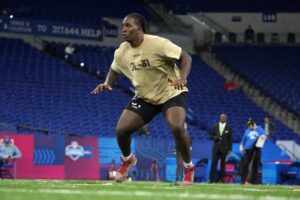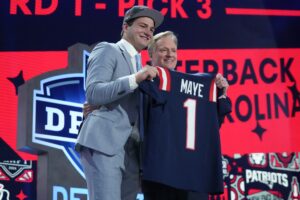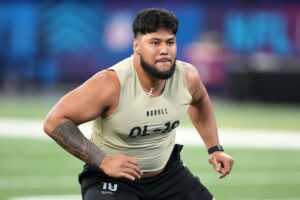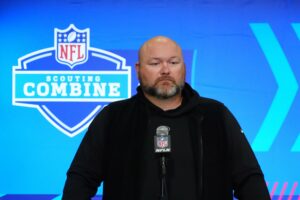The National Institute of Drug Abuse defines addiction as a chronic, relapsing brain disease that is characterized by compulsive drug seeking and use, despite harmful consequences. In fantasy football vernacular this equates to the concept of “take lock,” where drafters maintain a predetermined opinion of a player regardless of evidence to the contrary. There is a 2017 version of this addiction that needs to be immediately treated, so as to prevent the spread of a very misguided fantasy football belief.
In both PPR (point-per-reception) and standard scoring formats, the addiction to drafting New England Patriots tight end Rob Gronkowski ends only one way, and that is badly. Fantasy owners are making a crucial strategic mistake when drafting Gronkowski in seasonal leagues, and it needs to stop before even more drafters suffer the fate of watching their fantasy seasons crumble in mid-October.
It’s time to stop the “Gronk Madness.”
Fantasy Football: Stop Drafting Rob Gronkowski
Reason One: The Cost is Too High
Rob Gronkowski‘s current ADP on MFL10s (MyFantasyLeague) is 21.26 for PPR leagues, meaning on average he is selected in the second round. In MFL public league drafts, Gronkowski’s minimum draft spot is eighth overall and his maximum spot is 31st overall. Therefore, if your goal is to draft Rob Gronkowski, you will most likely need to spend a first or second round pick.
The majority of fantasy points for any redraft team are always accumulated from the early round selections. Below are the total PPR fantasy points from the last two seasons for running backs, wide receivers, and tight ends drafted in the first four rounds. Quarterbacks are excluded due to the depth of their position and the universally high scores regardless of ADP.
| 2016 RD 1-4 ADP | ||||||||||
| Player | PPR FPTS | Player | PPR FPTS | Player | PPR FPTS | Player | PPR FPTS | |||
| A. Brown | 307.5 | D. Bryant | 180 | M. Ingram | 242.2 | K. Benjamin | 197.1 | |||
| O. Beckham | 296.6 | L. Miller | 191.1 | T.Y. Hilton | 273.8 | C. Hyde | 192.1 | |||
| J. Jones | 259.9 | D. Freeman | 284.1 | S. Watkins | 83 | L. Murray | 208.2 | |||
| T. Gurley | 198.2 | K. Allen | 12.3 | D. Martin | 85.5 | G. Olsen | 207.5 | |||
| D. Johnson | 407.8 | M. Evans | 304.1 | L. McCoy | 299.3 | D. Baldwin | 253.6 | |||
| E. Elliott | 325.4 | J. Nelson | 304.7 | D. Thomas | 226.3 | M. Forte | 183.6 | |||
| A.J. Green | 186.4 | B. Marshall | 156.7 | J. Landry | 231.5 | G. Tate | 223.1 | |||
| D. Hopkins | 197.4 | A. Cooper | 230.9 | J. Reed | 168.6 | D. Moncrief | 102.6 | |||
| L. Bell | 317.4 | A. Jeffery | 146.1 | R. Cobb | 148.3 | J. Maclin | 109.5 | |||
| R. Gronkowski | 97 | J. Charles | 13.4 | C.J. Anderson | 102.5 | D. Murray | 293.8 | |||
| A. Peterson | 9 | B. Cooks | 246.9 | T. Rawls | 75.5 | T. Kelce | 223 | |||
| A. Robinson | 199.3 | E. Lacy | 42.8 | J. Edelman | 230.3 | E. Decker | 40.4 | |||
| AVG | 233.49 | 176.09 | 180.57 | 186.21 | ||||||
| 2015 RD 1-4 ADP | ||||||||||
| Player | PPR FPTS | Player | PPR FPTS | Player | PPR FPTS | Player | PPR FPTS | |||
| A. Brown | 382.2 | A.J. Green | 273.7 | A. Cooper | 212.7 | A. Ellington | 74.7 | |||
| A. Peterson | 260.7 | R. Cobb | 208.9 | L. Murray | 202.8 | A. Abdullah | 117.1 | |||
| E. Lacy | 140.6 | J. Hill | 170.3 | J. Edelman | 172.5 | J. Randle | 74 | |||
| J. Jones | 375.1 | L. McCoy | 178.7 | G. Tate | 209.4 | B. Marshall | 339.2 | |||
| O. Beckham | 319.3 | T.Y. Hilton | 211.4 | A. Morris | 96.6 | T.J. Yeldon | 155.9 | |||
| R. Gronkowski | 255.6 | M. Evans | 210.8 | A. Johnson | 115.3 | J. Stewart | 162.8 | |||
| D. Thomas | 267.4 | B. Cooks | 253.6 | G. Olsen | 227.4 | D. Adams | 106.3 | |||
| M. Lynch | 82.7 | D. Hopkins | 331.9 | T. Kelce | 189.5 | C.J. Spiller | 81.1 | |||
| M. Forte | 214.7 | L. Miller | 231.9 | S. Watkins | 218.8 | A. Robinson | 304 | |||
| C.J. Anderson | 141.3 | E. Sanders | 224.4 | T. Gurley | 208.6 | D. Jackson | 104.8 | |||
| C. Johnson | 261.4 | J. Matthews | 230.7 | J. Landry | 270.4 | D. Martin | 232.3 | |||
| D. Murray | 184.1 | F. Gore | 193.4 | J. Maclin | 242.9 | M. Bryant | 170.2 | |||
| AVG | 240.4 | 226.6 | 197.2 | 160.2 | ||||||
In 2016, owners that drafted Rob Gronkowski were at a major disadvantage because of his failure to match the expected production of a first round pick. While Gronkowski’s overall point total in 2015 was almost double that of last season, he still vastly underperformed in relation to the small fantasy point variance at the position.
If want to draft Rob Gronkowski in 2017, you need to be willing to spend a first or second round draft pick. With draft capital that high, he will need to produce at an incredibly high level to justify that selection. Even if he finishes as the TE1, if there are several other tight ends within 20 points of his production, the selection is a huge mistake.
Players like Antonio Brown, David Johnson, and Ezekiel Elliott were league winners last season because they performed at such a high level while also distancing themselves from the majority of their positional peers. Those players are even more valuable because of the weekly requirement to start multiple running backs and wide receivers.
Most fantasy players start only one tight end, which is also a critically overlooked issue.
Reason Two: There’s Only One Tight End Spot
In the majority of fantasy football leagues there is only one starting spot for the tight end position. While leagues exist that start two tight ends or have a bonus premium on tight end receptions (i.e. Scott Fish Bowl), that is not the norm. In leagues that start one tight end, the only justification for selecting a tight end in the first four rounds would be if they vastly outperformed all other positional players. While Rob Gronkowski accomplished that feat in 2011, that likelihood of a repeat this season is extremely slim.
Everyone remembers that incredible 2011 season. Gronkowski had 90 receptions, 1,327 yards, and caught 17 touchdown passes. From a fantasy football perspective, he was even better, finishing as the top fantasy tight end in standard scoring leagues by an overwhelming 35 points. Even more impressive? He accumulated more fantasy points than every single wide receiver except Detroit’s Calvin Johnson.
It is because of that specific year that fantasy owners are suffering from Rob Gronkowski Addiction. The “take lock” is based on their memory of a season in which Gronkowski was the dominant offensive force in fantasy football.
However, since that historic season, Gronkowski has failed to even come close to replicating that performance. Here are his last five fantasy seasons:
| Year | ADP | GP | Total Points | Rank | Receptions | Targets |
| 2012 | 19.7 | 11 | 198 | 5th | 55 | 79 |
| 2013 | 44.4 | 7 | 122.2 | 19th | 39 | 66 |
| 2014 | 30 | 15 | 266.4 | 1st | 82 | 131 |
| 2015 | 11.9 | 15 | 255.6 | 1st | 72 | 120 |
| 2016 | 13.9 | 8 | 97 | 26th | 25 | 38 |
Let’s examine each season in detail. In 2012, Gronkowski had an overall ADP of 19.7 and finished fifth in total fantasy points by a tight end. This was a bust season.
In 2013, there was an ADP correction (ADP 44.4), but Gronkowski still disappointed. Due to injuries, he only played seven games and finished as the 19th best fantasy tight end. Even with a fourth round ADP, Gronkowski’s performance failed to match his draft capital.
In 2014, Gronkowski had a very strong year finishing first with 266.4 total points, and outpacing the next closest tight end (Jimmy Graham) by 37 points. With a third round ADP, this was certainly a successful year for Gronkowski fantasy supporters.
However, those same fantasy players cannot lay the same claim about the 2015 season. While Gronkowski did finish as the number one overall tight end in fantasy, there was only an 18 fantasy point difference between the top four fantasy tight ends. Even more interesting? Washington Redskins tight end Jordan Reed averaged more fantasy points per game (17.4) in one less total game than Gronkowski (17.0). That is poor value for a player that actually had a first round ADP at 11.9.
The 2016 season? Another huge disappointment for Gronkowski fantasy owners. He finished with a 26th ranking in total fantasy points among tight ends, after having an early second round ADP.
If you are going to fill a position that only requires one starter with an early round pick, that player needs to vastly outperform his positional peers. Rob Gronkowski failed to accomplish that in 2012, 2013, 2015, and 2016.
The key to that historical 2011 fantasy season was that the point difference between Gronkowski and the rest of the tight end position was enormous. Since then he’s still been good (when healthy), but the overall tight end production gap has been drastically reduced.
Reason Three: Narrowing the Gap
Most fantasy owners subscribe to a late round quarterback philosophy, citing the depth of viable fantasy options at the position. Ask yourself: why isn’t “late round tight end” just as popular?
With the increased popularity in three wide receiver sets, the tight end production has become much less varied. Take a look at the data for the top 20 fantasy PPR tight ends from 2011-2016.
| Q1 | Median | Q3 | IQR | Upper Fence | Lower Fence | TE1 | FPts | |
| 2011 | 140.5 | 174.8 | 200.1 | 59.8 | 289.4 | 51.1 | R. Gronkowski | 330.9 |
| 2012 | 131.1 | 162 | 194.4 | 63.4 | 289.5 | 36 | J. Graham | 237.2 |
| 2013 | 131.3 | 162 | 211.8 | 80.6 | 332.7 | 10.5 | J. Graham | 303.5 |
| 2014 | 134.2 | 162 | 209.9 | 75.7 | 323.5 | 20.6 | R. Gronkowski | 266.4 |
| 2015 | 127.9 | 162.2 | 218.4 | 90.6 | 354.2 | -7.88 | R. Gronkowski | 255.6 |
| 2016 | 136.5 | 160.2 | 187 | 50.5 | 262.7 | 60.7 | T. Kelce | 223 |
By statistical definition, an outlier is a number that falls above the upper fence or below the lower fence of a group of data. For our purposes, we are only examining the upper fence which is calculated by adding 1.5 times the Interquartile Range (IQR) to the third quartile (Q3). In Gronkowski’s historic 2011 season, the upper quartile was 200.1 with an IQR of only 59.8. The translates to low variance among the top 20 fantasy tight ends. Gronkowski’s 330.9 PPR fantasy point season blew away the upper fence of 289.4. That completely justified taking Rob Gronkowski in the early rounds, and made him a league winner for many fantasy teams.
The only other year where taking a tight end early could be justified was 2013 when Jimmy Graham (86 recs, 1215 yards, 16 touchdowns) came close to enjoying true outlier status while with the New Orleans Saints.
Since that 2011 season, the median for top 20 tight end fantasy production has remained consistently around 160 fantasy points, while the upper quartile has gradually increased to a high of 218.4 in 2015. This means there are more tight ends scoring above the median.
As for this past season, the upper quartile did drop to 187, but so did the spread of the overall tight end production as shown by the 50.5 IQR. This still indicates a low variance spread among tight end fantasy production.
The elite tight ends are not separating themselves from the pack, and the respective low variance makes the justification for taking Rob Gronkowski with an early round pick simply nonexistent.
Reason Four: Opportunities Lost
As we mentioned earlier, the early round picks are always the most important for building your foundation towards a seasonal fantasy championship regardless of format. By selecting Rob Gronkowski in the early rounds of your draft, you also choose to not draft several fantastic running back and wide receiver options.
Given Gronkowski’s ADP, he will be selected in the late first to late second round range. Let’s examine the rationale from three groups of draft spots:
- Early (Picks One to Four): The chance of acquiring Rob Gronkowski from an early first round draft position is slim. You are never drafting him in the first four picks, so it must be in the late second round. In most drafts, he simply won’t be available from this range. If he is somehow still available at picks 21-24, Gronkowski should still not be selected. Assuming you select a running back at your first spot, you are missing out on a top tier wide receiver in any format by selecting him with that second round pick. According to MyFantasyLeague ADP, the best available wide receivers in this draft range in round three would be Brandin Cooks, Allen Robinson, Demaryius Thomas, and Sammy Watkins. In a three wide receiver or flex roster format, having any of those players as your WR1 puts your team at a huge disadvantage.
- Middle (Picks Five to Eight): Given Gronkowski’s current ADP, you may have to actually select him with a first round pick in this draft range. This puts an inordinate amount of pressure on your second round pick, and commits the need to be perfect on late round running backs or wide receivers. If he falls to round two in this draft position, your third round pick is in the 29-32 range. If that picks represents your first running back selection, the options are Christian McCaffrey, Isaiah Crowell, Joe Mixon, or Marshawn Lynch as your top running back. If you still need a wide receiver in round three, the best choices via ADP would be Thomas, Watkins, Keenan Allen, or Jarvis Landry. In either instance, very suboptimal roster construction.
- Late (Picks Nine to 12): The good news is that Gronkowski can be selected with either pick in this draft range. The bad news is the drafter must then wait an eternity for a third round selection. While this is the area Gronkowski is most likely to be selected, it also carries the most risk because of the long wait between the second and third rounds. If Gronkowski and a wide receiver are selected, the drafter is resigned to a Zero RB draft. If selected with a running back, the best available wide receiver scenario in round three is Detroit’s Golden Tate.
Missing out on a top tier wide receiver or running back in those early rounds will again put too much pressure to have Gronkowski perform at that statistical “outlier” level. It’s a risk that should never be taken.
Reason Five: New England Weaponry
The Patriots have assembled the most talented and varied roster in the Belichick-Brady era. It is foolish to project any one specific player to receive the overwhelming majority of passing targets. Not only is Rob Gronkowski overpriced, so are most of the Patriots receivers in general.
Looking at Randy Moss‘ amazing 2007 season with the Patriots, he had 160 of the team’s 586 targets (27.3 percent). Second was Wes Welker with 145 targets (24.7 percent), meaning both he and Moss combined for an incredible 52 percent of the passing targets that season.
With Brandin Cooks, Julian Edelman, Chris Hogan, Danny Amendola, Malcolm Mitchell, and veteran Andrew Hawkins, the New England wide receiver core is stronger and deeper than ever. They are all accomplished receivers that will provide solid target options for quarterback Tom Brady.
The Patriots also have great receivers in their backfield. Dion Lewis, James White, Rex Burkhead, Brandon Bolden, and Mike Gillislee are all multi-dimensional running backs that create mismatches with linebackers in the passing game.
As if that wasn’t enough, Rob Gronkowski will also have to contend with newly acquired fellow tight end Dwayne Allen, who was the red zone favorite of quarterback Andrew Luck in Indianapolis.
Is this the competition for targets you want from your first or second round fantasy draft pick? Certainly not.
Summary
The price for acquiring Rob Gronkowski on your fantasy team this season is too high. He not performed at a level to justify that type of draft capital in five seasons. In addition, most leagues only have one tight end spot and the variance at the position has closed dramatically.
Throw in the great running back/wide receiver fantasy options that are available in the early rounds along with the New England target competition, and there is simply no justification for targeting Rob Gronkowski in any seasonal fantasy football draft. “Gronk” is the best tight end in football, but he should be completely avoided in all redraft fantasy leagues.
Main Photo:






